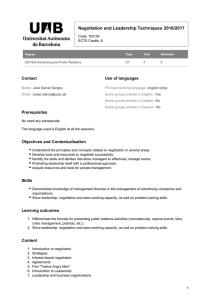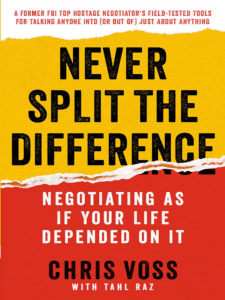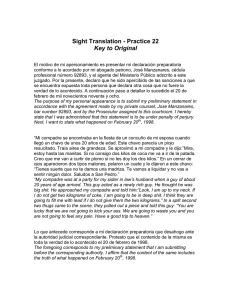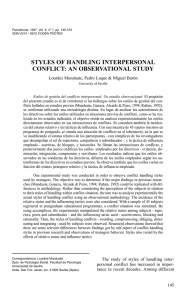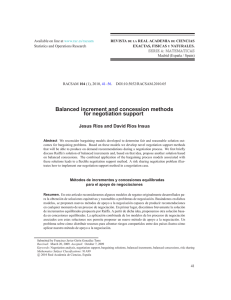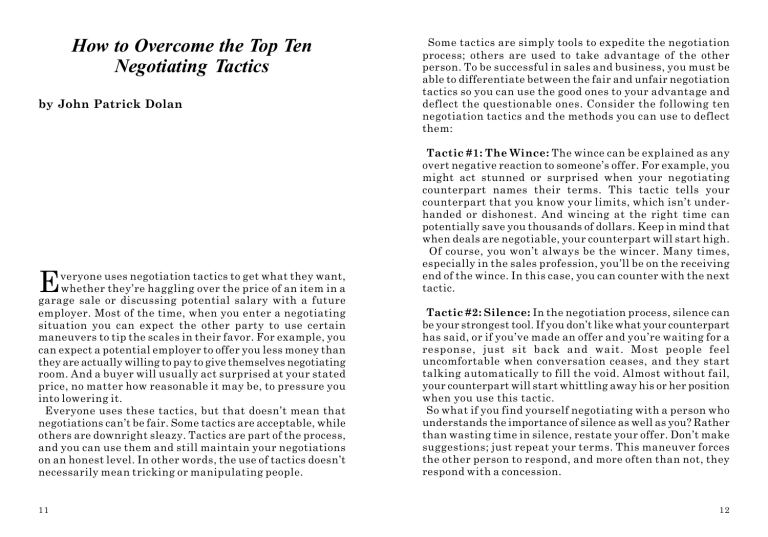
How to Overcome the Top Ten Negotiating Tactics by John Patrick Dolan E veryone uses negotiation tactics to get what they want, whether they’re haggling over the price of an item in a garage sale or discussing potential salary with a future employer. Most of the time, when you enter a negotiating situation you can expect the other party to use certain maneuvers to tip the scales in their favor. For example, you can expect a potential employer to offer you less money than they are actually willing to pay to give themselves negotiating room. And a buyer will usually act surprised at your stated price, no matter how reasonable it may be, to pressure you into lowering it. Everyone uses these tactics, but that doesn’t mean that negotiations can’t be fair. Some tactics are acceptable, while others are downright sleazy. Tactics are part of the process, and you can use them and still maintain your negotiations on an honest level. In other words, the use of tactics doesn’t necessarily mean tricking or manipulating people. 11 Some tactics are simply tools to expedite the negotiation process; others are used to take advantage of the other person. To be successful in sales and business, you must be able to differentiate between the fair and unfair negotiation tactics so you can use the good ones to your advantage and deflect the questionable ones. Consider the following ten negotiation tactics and the methods you can use to deflect them: Tactic #1: The Wince: The wince can be explained as any overt negative reaction to someone’s offer. For example, you might act stunned or surprised when your negotiating counterpart names their terms. This tactic tells your counterpart that you know your limits, which isn’t underhanded or dishonest. And wincing at the right time can potentially save you thousands of dollars. Keep in mind that when deals are negotiable, your counterpart will start high. Of course, you won’t always be the wincer. Many times, especially in the sales profession, you’ll be on the receiving end of the wince. In this case, you can counter with the next tactic. Tactic #2: Silence: In the negotiation process, silence can be your strongest tool. If you don’t like what your counterpart has said, or if you’ve made an offer and you’re waiting for a response, just sit back and wait. Most people feel uncomfortable when conversation ceases, and they start talking automatically to fill the void. Almost without fail, your counterpart will start whittling away his or her position when you use this tactic. So what if you find yourself negotiating with a person who understands the importance of silence as well as you? Rather than wasting time in silence, restate your offer. Don’t make suggestions; just repeat your terms. This maneuver forces the other person to respond, and more often than not, they respond with a concession. 12 Tactic #3: The Good Guy/Bad Guy Routine: This sleazy tactic is often used in movies, where two detectives are interrogating a person who’s just been arrested. One detective seems unreasonable and inflexible, while the other tries to make it look like he or she is on the suspect’s side. This tactic is designed to get you to make concessions without the other side making any in return. If you find yourself in a good guy/bad guy situation, the best response is to ignore it. Recognize this game for what it is, but don’t play along and don’t allow the good guy to influence your decision. The best technique is to let your counterparts play their game, while you watch out for your own interests. Tactic #4: Limited Authority: This tactic is a variation on the good guy/bad guy routine, but instead of two people working over you, the one person you’re dealing with tells you that he or she must approve any deals with an unseen higher authority. Sometimes, this higher authority exists, but other times your counterpart will create this figure to gain an edge in the negotiation process. So just because your counterpart tells you, “It’s out of my hands,” don’t automatically assume the person is being honest. In this type of situation, two options exist: one, ask to deal directly with this so-called higher authority; or two, test the limits of your counterpart. You may find that although the other person has used this tactic to force you into backing down, if you keep at him or her, you may get what you want. Tactic #5: The Red Herring: This technique comes from fox hunting competitions, where one team drags a dead fish across the fox’s path to distract the other team’s dogs. At the bargaining table, a red herring means one side brings up a minor point to distract the other side from the main issue. Effective and ethical negotiators generally agree that this tactic is the sleaziest of them all. 13 When your negotiation process is bogged down with a minor problem, and your counterpart insists on settling it before they’ll even talk about more important issues, then you are probably dealing with a red herring. In this case, use extreme caution, and suggest setting the issue aside temporarily to work out other details. Tactic #6: The Trial Balloon: Trial balloons are questions designed to assess your negotiating counterpart’s position without giving any clues about your plans. For example, you may ask your counterpart, “Would you consider trying our services on a temporary basis?” or “Have you considered our other service plans?” Essentially, these types of questions put the ball in your counterpart’s court, and the nice part about them is they aren’t really offers. They allow you to gain information without making a commitment. When you’re on the receiving end of a trial balloon question, you may feel compelled to answer it thoroughly. To maintain your edge, resist this temptation and counter with another question. For example, if someone asks, “Would you consider financing the house yourself?” respond, “Well, if I did, what would your offer be?” Tactic #7: Low-Balling: Low-balling is the opposite of the trial balloon. Instead of tempting you to make the first offer, your counterpart will open the process with a fantastic offer. Then after you agree, they start hitting you with additional necessities. For example, say you see an ad for a product priced lower than other stores. But then after you agree to buy, the sales representative uncovers the hidden costs, such as shipping or installation. In the end you probably pay more than you would have at another store listing a higher price on the product. To avoid falling victim to this tactic, ask your counterpart about additional costs before agreeing to any deal. 14 Tactic #8: The Bait-and-Switch: Similar to low-balling, the bait-and-switch tactic should be avoided. Your counterpart may try to attract your interests with one great offer, but then hook you with another mediocre one. This tactic will almost always burn you, unless you can recognize it. If your counterpart were really able to offer a genuinely good deal, they wouldn’t have to resort to baitand-switch. Better Negotiations in the Future: People have used these ten negotiation tactics for years, but that doesn’t mean they are always fair. So before you rush into your next negotiation situation, make yourself aware of these tactics and how they affect the process. When you learn the uses and defenses of these negotiation techniques, you can reach more mutually beneficial agreements and win more sales on better terms. Tactic #9: Outrageous Behavior: Outrageous behavior can be categorized as any form of socially unacceptable conduct intended to force the other side to make a move, such as throwing a fit of anger or bursting into tears. As most people feel uncomfortable in these situations, they may reduce their negotiating terms just to avoid them. However, the most effective response to outrageous behavior is none at all. Just wait for the fit to die down before reacting, because emotional negotiations can result in disaster. Tactic #10: The Written Word: When terms of a deal are written out, they often seem non-negotiable. For example, when was the last time you negotiated a lease, or a loan, or even a service contract that was typed up in advance in an official-looking document? You probably assumed these deals were non-negotiable, and for some reason most people make the same mistake of accepting terms that appear in writing. The best defense against this tactic is simply to question everything, whether it appears in writing or not. You’ll inevitably run into some standard, non-negotiable documents, but it never hurts to ask questions. You may be surprised how many contracts actually are negotiable when challenged. 15 ©John Patrick Dolan is a highly praised convention presenter, member of the National Speakers Association Speakers Hall of Fame, and author of the best selling book “Negotiate Like the Pros.” His offices can be reached at 888-830-2620, or by email at [email protected]. 16 Copyright of American Salesman is the property of National Research Bureau and its content may not be copied or emailed to multiple sites or posted to a listserv without the copyright holder's express written permission. However, users may print, download, or email articles for individual use.

